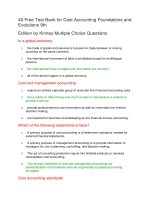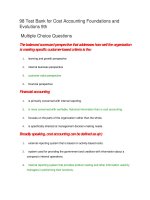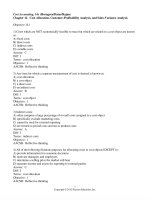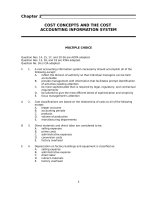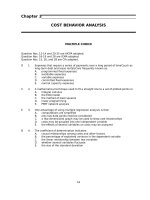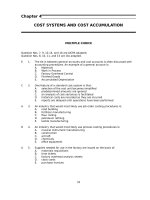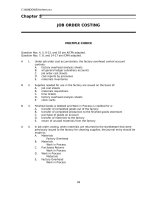Test bank cost accounting foundations and evolutions 8e by raiborn chapter 9
Bạn đang xem bản rút gọn của tài liệu. Xem và tải ngay bản đầy đủ của tài liệu tại đây (575.55 KB, 630 trang )
��#��###<################ �
#ࡱ
�������###################�###�###�####����#####################################
��������������������������������������������������������������������������������
��������������������������������������������������������������������������������
��������������������������������������������������������������������������������
��������������������������������������������������������������������������������
��������������������������������������������������������������������������������
##���
ࡱ###############���
# #######bjbjUqUq##################
###(n##7###7###'�##############################��##########��##########��#######
###########l#####�#######�###�#######�#######�#######�#######�##################
#####b�######b�######b�##8###��##�###F�##�
##########"e##�###F�######F�##"###h�######h�######h�######C�######C�######C�####
##�c######�c######�c######�c######�c######�c######�c##$####f##
###8h##�###�c######################�#######C�######################C�######C�###
###C�######C�######�c######[#######�#######�#######h�##############h�##�###�d###
###[#######[#######[#######C�##�###�#######h�######�#######h�######�c###########
###[#######################################################C�######�c######[###�
###[###############Q#######�#######�############################################
###################Q#######h�######:�##
###@#o#z&�#####P�##b�######��##�###Q###############Q###T[##�d##0###"e######Q####
####i######�###�####i######Q#######[#######################�#######�#######�####
###�#########�###Chapter 9--Break-Even Point and Cost-Volume-Profit Analysis
LEARNING OBJECTIVES
LO 1#Why is variable costing more useful than absorption
costing in determining thebreak-even point and doing cost-volume-profit
analysis?##LO 2#How is the break-even point determined using the formula
approach, graphapproach, and income statement approach?##LO 3#How can a company
use cost-volume-profit (CVP) analysis?##LO 4#How do break-even and CVP analysis
differ for single-product and multiproduct firms?##LO 5#How are margin of safety
and operating leverage concepts used in business?##LO 6#What are the underlying
assumptions of CVP analysis?##QUES
TION GRID
True/False###########D
ifficulty
Level#Learning Objectives##�#Easy#Moderate#D
ifficult#LO 1#LO 2#LO 3#LO 4#LO 5#LO
6##1#x#�#�#x#�#�#�#�#�##2#x#�#�#x#�#�#�#�#�##3#x#�#�#x#�#�#�#�#�##4#x#�#�#x#�#�#
�#�#�##5#x#�#�#x#�#�#�#�#�##6#x#�#�#x#�#�#�#�#�##7#x#�#�#x#�#�#�#�#�##8#x#�#�#x#
�#�#�#�#�##9#x#�#�#x#�#�#�#�#�##10#x#�#�#x#�#�#�#�#�##11#x#�#�#x#�#�#�#�#�##12#x
#�#�#�#x#�#�#�#�##13#x#�#�#�#x#�#�#�#�##14#x#�#�#�#�#x#�#�#�##15#x#�#�#�#�#x#�#�
#�##16#�#x#�#�#�#x#�#�#�##17#�#x#�#�#�#x#�#�#�##18#�#x#�#�#�#x#�#�#�##19#�#x#�#�
#�#x#�#�#�##20#�#x#�#�#�#x#�#�#�##21#�#x#�#�#�#x#�#�#�##22#�#x#�#�#�#x#�#�#�##23
#�#x#�#�#�#x#�#�#�##24#�#x#�#�#�#�#x#�#�##25#�#x#�#�#�#�#�#x#�##26#�#x#�#�#�#�#�
#x#�##27#�#x#�#�#�#�#�#x#�##28#�#x#�#�#�#�#�#�#x##Completion####�#�#�#�#�##�#D
if
ficulty Level#Learning Objectives###Easy#Moderate#D
ifficult#LO 1#LO 2#LO 3#LO
4#LO 5#LO
6##1#x#�#�#x#�#�#�#�#�##2#x#�#�#�#x#�#�#�#�##3#x#�#�#�#�#x#�#�#�##4#�#x#�#�#�#�#
�#x#�##5#�#x#�#�#�#�#�#x#�##6#�#x#�#�#�#�#�#x#�##7#�#x#�#�#�#�#�#x#�##Multiple
Choice##########�#D
ifficulty Level#Learning
Objectives##�#Easy#Moderate#D
ifficult#LO 1#LO 2#LO 3#LO 4#LO 5#LO
6##1#x#�#�#x#�#�#�#�#x##2#x#�#�#�#x#�#�#�#x##3#x#�#�#�#x#�#�#�#x##4#x#�#�#�#x#�#
�#�#x##5#x#�#�#�#x#�#�#�#�##6#x#�#�#�#x#�#�#�#�##7#x#�#�#�#x#�#�#�#x##8#x#�#�#�#
x#�#�#�#�##9#x#�#�#�#x#�#�#�#�##10#x#�#�#�#x#�#�#�#�##11#x#�#�#�#x#�#�#�#�##12#x
#�#�#�#x#�#�#�#�##13#x#�#�#�#x#�#�#�#�##14#x#�#�#�#x#�#�#�#�##15#�#x#�#�#x#�#�#�
#�##16#�#x#�#�#x#�#�#�#�##17#x#�#�#�#x#�#�#�#x##18#x#�#�#�#x#�#�#�#�##19#x#�#�#�
#x#�#�#�#�##20#x#�#�#�#x#�#�#�#x##21#x#�#�#�#
#�#x#�#x##22#x#�#�#�#�#x#�#�#�##23#x#�#�#�#�#�#�#x#�##24#x#�#�#�#�#�#�#x#�##25#�
#x#�#�#�#�#�#x#�##26#�#x#�#�#�#�#�#x#�##27#�#x#�#�#�#�#�#x#�##28#�#x#�#�#�#�#�#x
#�##29#�#x#�#�#�#x#�#�#�##30#x#�#�#�#�#�#�#x#�##31#�#x#�#�#�#x#�#�#�##32#�#x#�#�
#�#x#�#�#�##33#�#x#�#�#�#�#�#x#�##34#�#x#�#�#�#x#�#�#�##35#�#x#�#�#�#x#�#�#�##36
#�#x#�#�#�#�#�#x#�##37#�#x#�#�#�#x#�#�#�##38#�#x#�#�#�#�#x#�#�##39#�#x#�#�#�#�#x
#�#�##40#�#x#�#�#�#�#x#�#�##41#�#x#�#�#�#�#�#x#�##42#�#x#�#�#�#x#�#�#�##43#�#x#�
#�#�#x#�#�#�##44#�#x#�#�#�#x#�#�#�##45#�#x#�#�#�#�#�#x#�##46#�#x#�#�#�#�#�#x#�##
47#x#�#�#�#�#x#�#�#�##48#x#�#�#�#�#x#�#�#�##49#�#X#�#�#�#x#�#�#�##50#�#�#x#�#�#x
#�#�#�##51#�#X#�#�#�#x#�#�#�##52#�#X#�#�#�#x#�#�#�##53#�#X#�#�#�#x#�#�#�##54#x#�
#�#�#�#x#�#�#�##55#�#X#�#�#�#x#�#�#�##56#x#�#�#�#�#x#�#�#�##
�#D
ifficulty Level#Learning Objectives##�#Easy#Moderate#D
ifficult#LO 1#LO 2#LO
3#LO 4#LO 5#LO
6##57#x#�#�#�#�#x#�#�#�##58#�#x#�#�#�#x#�#�#�##59#x#�#�#�#�#x#�#�#�##60#x#�#�#�#
�#x#�#�#�##S
hort Answer�#�#�#�#�#�#�#�#�##�#D
ifficulty Level#Learning
Objectives##�#Easy#Moderate#D
ifficult#LO 1#LO 2#LO 3#LO 4#LO 5#LO
6##1#�#x#�#�#x#�#�#�#x##2#�#x#�#�#�#�#x#�#�##3#�#x#�#�#�#�#�#x#�##4#�#x#�#�#�#�#
�#�#x##Problem#�#�#�#�#�#�#�#�#�##�#D
ifficulty Level#Learning
Objectives##�#Easy#Moderate#D
ifficult#LO 1#LO 2#LO 3#LO 4#LO 5#LO
6##1#�#x#�#�#�#�#x#�#�##2#�#x#�#�#�#�#x#�#�##3#�#x#�#�#�#�#x#�#�##4#�#x#�#�#�#x#
�#�#�##5#�#x#�#�#�#�#�#x#�##6#�#x#�#�#�#�#x#�#�##7#�#x#�#�#�#�#x#�#�##8#�#x#�#�#
�#x#�#�#�##9#�#x#�#�#�#x#�#�#�##10#�#x#�#�#�#�#x#�#�##11#�#x#�#�#�#�#x#�#�##
TRUE/FALS
E 1.
A company�s break-even point is the level where total revenues
equal total costs.ANS
: T
D
IF: Easy OBJ: 9-1
2.
Absorption costing is
more useful than variable costing in determining a company�s break-even point.
ANS
: F
D
IF: Easy OBJ: 9-1
3.
Variable costing is more useful than
absorption costing in determining a company�s break-even point.ANS
:
T
D
IF: Easy OBJ: 9-1
4.
Total variable costs vary directly with
levels of production.ANS
:
T
D
IF: Easy OBJ: 9-1
5.
Variable costs
per unit vary directly with levels of production.ANS
: F
D
IF: Easy OBJ: 9-1
6.
Variable costs per unit remain unchanged with levels of production.
ANS
: T
D
IF: Easy OBJ: 9-1
7.
Total fixed costs remain unchanged
with levels of production.ANS
:
T
D
IF: Easy OBJ: 9-1
8.
Total
fixed costs vary inversely with levels of production.ANS
: F
D
IF: Easy
OBJ: 9-1
9.
Fixed costs per unit vary inversely with levels of
production.ANS
:
T
D
IF: Easy OBJ: 9-1
10.
Fixed costs per unit remain
constant with levels of production.ANS
: F
D
IF: Easy OBJ: 9-1
11.
Break-even point may be expressed in terms of units or dollars.ANS
:
T
D
IF: Easy OBJ: 9-1
12.
D
ividing total fixed costs by the
contribution margin ratio yields break-even point in sales dollars.ANS
:
T
D
IF: Easy OBJ: 9-2
13.
D
ividing total fixed costs by the contribution margin ratio yields
break-even point in units.ANS
:
F
D
IF: Easy OBJ: 9-2
14.
After the
break-even point is reached, each dollar of contribution margin is a dollar of
before-tax profit.ANS
: T
D
IF: Easy OBJ: 9-3
15.
After the break-even
point is reached, each dollar of contribution margin is a dollar of after-tax
profit.ANS
: F
D
IF: Easy OBJ: 9-3
16.
When using CVP analysis to
determine sales level for a desired amount of profit, the profit is treated as
an additional cost to be covered.ANS
:
T
D
IF: Moderate
OBJ: 9-3
17.
When computing profit on an after-tax basis, it is necessary to divide the
pretax profit by the effective tax rate.ANS
:
F
D
IF: Moderate
OBJ: 9-3
18.
When computing profit on an after-tax basis, it is necessary to
divide the pretax profit by (1 - effective tax rate).ANS
: T
D
IF: Moderate
OBJ: 9-3
19.
On a CVP graph, the total cost line intersects the yaxis at zero.ANS
: F
D
IF: Moderate
OBJ: 9-3
20.
On a CVP graph, the
total variable cost line intersects the y-axis at zero.ANS
:T
D
IF: Moderate
OBJ: 9-3
21.
On a CVP graph, the total revenue line intersects the yaxis at zero.ANS
: T
D
IF: Moderate
OBJ: 9-3
22.
On a CVP graph, the
total fixed cost line parallels the x-axis.ANS
: T
D
IF: Moderate
OBJ: 9-3
23.
Incremental analysis focuses on factors that change from one
decision to another.ANS
:
T
D
IF: Easy OBJ: 9-3
24.
In a multiproduct environment, CVP analysis makes the assumption that a company�s sales
mix is constant.ANS
:
T
D
IF: Moderate
OBJ: 9-4
25.
The margin of
safety is an effective measure of risk for a company.ANS
: T
D
IF: Moderate
OBJ: 9-5
26.
There is an inverse relationship between degree of
operating leverage and the margin of safety.ANS
:
T
D
IF: Moderate
OBJ: 9-5
27.
The margin of safety is computed by dividing 1 by the
degree of operating leverage.ANS
: T
D
IF: Moderate
OBJ: 9-5
28.
In
CVP analysis, sales and production are assumed to be equal.ANS
: T
D
IF:
Moderate
OBJ: 9-6COMPLETION
1.
The level of activity where a
company�s total revenues equal total costs is referred to as the
______________________________.ANS
: break-even pointD
IF:
Easy OBJ: 9-1
2.
Contribution margin divided by revenue is referred to as the
_______________________.ANS
: contribution margin ratioD
IF: Easy OBJ: 9-2
3.
A process that focuses only on factors that change from one course of
action to another is referred to as __________________________________.ANS
:
incremental analysisD
IF:
Easy OBJ: 9-3
4.
The excess of
budgeted or actual sales over sales at break-even point is referred to as
_________________________________.ANS
:
margin of safetyD
IF:
Moderate
OBJ: 9-5
5.
The relationship between a company�s variable costs and
fixed costs is referred to as its ______________________________.ANS
: operating
leverageD
IF:
Moderate
OBJ: 9-5
6.
The
__________________________________ is computed by dividing the contribution
margin by profit before tax.ANS
:
degree of operating leverageD
IF:
Moderate
OBJ: 9-5
7.
The formula for margin of safety is
________________________________________.ANS
: 1 � D
egree of Operating Leverage
D
IF: Moderate
OBJ: 9-5MULTIPLE CHOICE
1.
CVP analysis requires costs
to be categorized asa.#either fixed or variable.##b.#fixed, mixed, or
variable.##c.#product or period.##d.#standard or actual.##ANS
:
A
D
IF:
Easy OBJ: 9-1,9-6
2.
With respect to fixed costs, CVP analysis
assumes total fixed costsa.#per unit remain constant as volume
changes.##b.#remain constant from one period to the next.##c.#vary directly with
volume.##d.#remain constant across changes in volume.##ANS
:D
D
IF: Easy
OBJ: 9-2,9-6
3.
CVP analysis relies on the assumptions that costs
are either strictly fixed or strictly variable. Consistent with these
assumptions, as volume decreases totala.#fixed costs decrease.##b.#variable
costs remain constant.##c.#costs decrease.##d.#costs remain constant.##ANS
: C
D
IF: Easy OBJ: 9-2,9-6
4.
According to CVP analysis, a company
could never incur a loss that exceeded its totala.#variable costs.##b.#fixed
costs.##c.#costs.##d.#contribution margin.##ANS
:
C
D
IF: Easy OBJ: 92,9-6 5.
CVP analysis is based on concepts froma.#standard
costing.##b.#variable costing.##c.#job order costing.##d.#process costing.##ANS
:
B
D
IF: Easy OBJ: 9-2
6.
Cost-volume-profit analysis is a
technique available to management to understand better the interrelationships of
several factors that affect a firm's profit. As with many such techniques, the
accountant oversimplifies the real world by making assumptions. Which of the
following is not a major assumption underlying CVP analysis?a.#All costs
incurred by a firm can be separated into their fixed and variable
components.##b.#The product selling price per unit is constant at all volume
levels.##c.#Operating efficiency and employee productivity are constant at all
volume levels.##d.#For multi-product situations, the sales mix can vary at all
volume levels.##ANS
:
D
D
IF: Easy OBJ: 9-2
7.
In CVP analysis,
linear functions are assumed fora.#contribution margin per unit.##b.#fixed cost
per unit.##c.#total costs per unit.##d.#all of the above.##ANS
: A
D
IF:
Easy OBJ: 9-2,9-6
8.
Which of the following factors is involved
in studying cost-volume-profit relationships?a.#product mix##b.#variable
costs##c.#fixed costs##d.#all of the above##ANS
:
D
D
IF: Easy OBJ: 9-2
9.
Cost-volume-profit relationships that are curvilinear may be
analyzed linearly by considering onlya.#fixed and mixed costs.##b.#relevant
fixed costs.##c.#relevant variable costs.##d.#a relevant range of volume.##ANS
:
D
D
IF: Easy OBJ: 9-2
10.
After the level of volume exceeds the
break-even pointa.#the contribution margin ratio increases.##b.#the total
contribution margin exceeds the total fixed costs.##c.#total fixed costs per
unit will remain constant.##d.#the total contribution margin will turn from
negative to positive.##ANS
:
B
D
IF: Easy OBJ: 9-2
11.
Which of the
following will decrease the break-even point?D
ecrease infixed cost#Increase in
directlabor cost#Increase inselling price##a.#yes
yes
yes##b.#yes
no
yes##c.#yes
no
no##d.#no
yes
no##ANS
: B
D
IF: Easy OBJ: 9-2
12.
At the break-even point, fixed costs are alwaysa.#less than the
contribution margin.##b.#equal to the contribution margin.##c.#more than the
contribution margin.##d.#more than the variable cost.##ANS
:B
D
IF: Easy
OBJ: 9-2
13.
The method of cost accounting that lends itself to
break-even analysis isa.#variable.##b.#standard.##c.#absolute.##d.#absorption.##
ANS
: A
D
IF: Easy OBJ: 9-2
14.
Given the following notation, what is
the break-even sales level in units?S
P = selling price per unit, FC = total
fixed cost, VC = variable cost per unita.#S
P/(FC/VC)##b.#FC/(VC/S
P)##c.#VC/(S
P FC)##d.#FC/(S
P - VC)##ANS
:
D
D
IF: Easy OBJ: 9-2
15.
Consider the
equation X = S
ales - [(CM/S
ales)
################################################################################
################################################################################
#########################�� #(#S
#a#l#e#s#)#]#.# #W#h#a#t# #i#s# #X#?#
#a#.###n#e#t# #i#n#c#o#m#e#####b#.###f#i#x#e#d#
#c#o#s#t#s#####c#.###c#o#n#t#r#i#b#u#t#i#o#n#
#m#a#r#g#i#n#####d#.###v#a#r#i#a#b#l#e# #c#o#s#t#s#######A#N#S
#:#
#D
#
#D
#I#F#:#
#M#o#d#e#r#a#t#e# #O#B#J#:#
#9#-#2###
#1#6#.#
#I#f# #a#
#f#i#r#m#'#s# #n#e#t# #i#n#c#o#m#e# #d#o#e#s# #n#o#t# #c#h#a#n#g#e# #a#s#
#i#t#s# #v#o#l#u#m#e# #c#h#a#n#g#e#s#,# #t#h#e# #f#i#r#m#(#'#s#)##a#.###m#u#s#t#
#b#e# #i#n# #t#h#e# #s#e#r#v#i#c#e# #i#n#d#u#s#t#r#y#.#####b#.###m#u#s#t# #h#ave
no fixed costs.##c.#sales price must equal $0.##d.#sales price must equal its
variable costs.##ANS
:
D
D
IF: Moderate
OBJ: 9-2
17.
Break-even
analysis assumes over the relevant range thata.#total variable costs are
linear.##b.#fixed costs per unit are constant.##c.#total variable costs are
nonlinear.##d.#total revenue is nonlinear.##ANS
:
A
D
IF: Easy OBJ: 92,9-6
18.
To compute the break-even point in units, which of the following
formulas is used?a.#FC/CM per unit##b.#FC/CM ratio##c.#CM/CM
ratio##d.#(FC+VC)/CM ratio##ANS
:
A
D
IF: Easy OBJ: 9-2
19.
A firm's
break-even point in dollars can be found in one calculation using which of the
following formulas?a.#FC/CM per unit##b.#VC/CM##c.#FC/CM ratio##d.#VC/CM ratio##
ANS
: C
D
IF: Easy OBJ: 9-2
20.
The contribution margin ratio always
increases when thea.#variable costs as a percentage of net sales
increase.##b.#variable costs as a percentage of net sales decrease.##c.#breakeven point increases.##d.#break-even point decreases.##ANS
:B
D
IF: Easy
OBJ: 9-2,9-6
21.
In a multiple-product firm, the product that has
the highest contribution margin per unit willa.#generate more profit for each $1
of sales than the other products.##b.#have the highest contribution margin
ratio.##c.#generate the most profit for each unit sold.##d.#have the lowest
variable costs per unit.##ANS
:
C
D
IF: Easy OBJ: 9-4,9-6
22.
_____________ focuses only on factors that change from one course of
action to another.a.#Incremental analysis##b.#Margin of safety##c.#Operating
leverage##d.#A break-even chart##ANS
:
A
D
IF: Easy OBJ: 9-3
23.
The
margin of safety would be negative if a company('s)a.#was presently operating at
a volume that is below the break-even point.##b.#present fixed costs were less
than its contribution margin.##c.#variable costs exceeded its fixed
costs.##d.#degree of operating leverage is greater than 100.##ANS
:
A
D
IF: Easy OBJ: 9-5
24.
The margin of safety is a key concept of CVP analysis. The margin of
safety is thea.#contribution margin rate.##b.#difference between budgeted
contribution margin and actual contribution margin.##c.#difference between
budgeted contribution margin and break-even contribution margin.##d.#difference
between budgeted sales and break-even sales.##ANS
:
D
D
IF: Easy OBJ: 9-5
25.
Management is considering replacing an existing sales commission
compensation plan with a fixed salary plan. If the change is adopted, the
company'sa.#break-even point must increase.##b.#margin of safety must
decrease.##c.#operating leverage must increase.##d.#profit must increase.##ANS
:
C
D
IF: Moderate
OBJ: 9-5
26.
As projected net income increases
thea.#degree of operating leverage declines.##b.#margin of safety stays
constant.##c.#break-even point goes down.##d.#contribution margin ratio goes
up.##ANS
:
A
D
IF: Moderate
OBJ: 9-5
27.
A managerial preference for
a very low degree of operating leverage might indicate thata.#an increase in
sales volume is expected.##b.#a decrease in sales volume is expected.##c.#the
firm is very unprofitable.##d.#the firm has very high fixed costs.##ANS
:
B
D
IF: Moderate
OBJ: 9-5Thompson CompanyBelow is an income statement
for Thompson Company:S
ales#$400,000�##Variable costs#(125,000)##Contribution
margin#$275,000�##Fixed costs#(200,000)##Profit before taxes#$ 75,000�##
28.
Refer to Thompson Company. What is Thompson�s degree of operating
leverage?a.#3.67##b.#5.33##c.#1.45##d.#2.67##ANS
:
A$(275,000/75,000) = 3.67##
D
IF: Moderate
OBJ: 9-5
29.
Refer to Thompson Company. Based on the cost
and revenue structure on the income statement, what was Thompson�s break-even
point in dollars?a.#$200,000##b.#$325,000##c.#$300,000##d.#$290,909##ANS
:
D
CM
Percentage = $(275/400) = .6875.6875x - $800,000 = 0
x = $290,909 ##D
IF:
Moderate
OBJ: 9-3
30.
Refer to Thompson Company. What was
Thompson�s margin of safety?a.#$200,000##b.#$75,000##c.#$100,000##d.#$109,091##
ANS
: D
Margin of S
afety = $(400,000 - 290,909)
=
$109,091##D
IF:
Easy OBJ: 9-5
31.
Refer to Thompson Company. Assuming
that the fixed costs are expected to remain at $200,000 for the coming year and
the sales price per unit and variable costs per unit are also expected to remain
constant, how much profit before taxes will be produced if the company
anticipates sales for the coming year rising to 130 percent of the current
year�s level?a.#$97,500##b.#$195,000##c.#$157,500##d.#A prediction cannot be
made from the information given.##ANS
:
CContribution Margin * 1.20 = New
Contribution Margin$275,000 * 1.20 = $357,500Contribution Margin - Fixed Costs =
Profit$(357,500 - 200,000) = $157,500##D
IF:
Moderate
OBJ: 9-3
Value ProValue Pro produces and sells a single product. Information on its costs
follow:Variable costs:###
S
G&A#$2 per unit##
Production#$4 per unit##Fixed
costs:###
S
G&A#$12,000 per year##
Production#$15,000 per year## 32.
Refer to Value Pro. Assume Value Pro produced and sold 5,000 units. At
this level of activity, it produced a profit of $18,000. What was Value Pro's
sales price per unit?a.#$15.00##b.#$11.40##c.#$9.60##d.#$10.00##ANS
:
AProfit +
Fixed Costs = Contribution Margin$18,000 + $27,000 = $45,000$45,000 / 5,000
units = $9 contribution margin per unitContribution Margin + Variable Costs =
S
ales Price/Unit$(9 + (4 + 2)) = $15/Unit##D
IF: Moderate
OBJ: 9-3
33.
Refer to Value Pro. In the upcoming year, Value Pro estimates that it will
produce and sell 4,000 units. The variable costs per unit and the total fixed
costs are expected to be the same as in the current year. However, it
anticipates a sales price of $16 per unit. What is Value Pro's projected margin
of safety for the coming year?a.#$7,000##b.#$20,800##c.#$18,400##d.#$13,000##
ANS
: BProfit at 4,000 unitsGross S
ales = $16 * 4,000 units = $64,000
Contribution Margin = $(16 - 6) = $10/unit($10*4,000) - $27,000 = $(40,000 27,000) = $13,000Breakeven0.625x - $27,000 = $0x = $43,200$(64,000 - 43,200) =
$20,800##D
IF:
Moderate
OBJ: 9-5
34.
Harris Manufacturing incurs
annual fixed costs of $250,000 in producing and selling a single product.
Estimated unit sales are 125,000. An after-tax income of $75,000 is desired by
management. The company projects its income tax rate at 40 percent. What is the
maximum amount that Harris can expend for variable costs per unit and still meet
its profit objective if the sales price per unit is estimated at $6?
a.#$3.37##b.#$3.59##c.#$3.00##d.#$3.70##ANS
:
CBefore Tax Income:
$75,000 /
0.60 = $125,000Fixed Costs:
250,000Contribution Margin:
$375,000Projected S
ales
$750,000
less: Contribution Margin
375,000Variable Costs
$375,000$375,000 / 125,000 units
$3/unit##D
IF:
Moderate
OBJ: 9-3Folk CompanyThe following information
relates to financial projections of Folk Company:Projected sales#60,000
units##Projected variable costs#$2.00 per unit##Projected fixed costs#$50,000
per year##Projected unit sales price#$7.00##
35.
Refer to Folk Company. How
many units would Folk Company need to sell to earn a profit before taxes of
$10,000?a.#25,714##b.#10,000##c.#8,571##d.#12,000##ANS
:
D
Contribution Margin
per Unit: $5 $5x - $50,000 - $10,000$5x = $60,000 x =
12,000 units##D
IF:
Moderate
OBJ: 9-3
36.
Refer to Folk Company. If Folk Company achieves its projections,
what will be its degree of operating leverage?
a.#6.00##b.#1.20##c.#1.68##d.#2.40##ANS
: BNet profit = (60,000 units * $5/unit)
- $50,000
= $300,000 - $50,000
= $250,000D
OL =
$(300,000/120,000) = 1.20 ##D
IF:
Moderate
OBJ: 9-5
37.
Unique Company
manufactures a single product. In the prior year, the company had sales of
$90,000, variable costs of $50,000, and fixed costs of $30,000. Unique expects
its cost structure and sales price per unit to remain the same in the current
year, however total sales are expected to increase by 20 percent. If the current
year projections are realized, net income should exceed the prior year�s net
income by:a.#100 percent.##b.#80 percent.##c.#20 percent.##d.#50 percent.##ANS
:
BContribution margin: $40,000Net profit:
$(40,000 - 30,000) =
$10,00020% CM increase:
$40,000 * 1.20 = $48,000Net profit:
$(48,000 - 30,000) = $18,000Increase in profit
$8,000$8,000/$10,000 =
80%##D
IF:
Moderate
OBJ: 9-3Eclectic CorporationEclectic Corporation
manufactures and sells two products: A and B. The operating results of the
company are as follows:#Product A#Product B##S
ales in units#2,000#3,000##S
ales
price per unit#$10#$5##Variable costs per unit#7#3##In addition, the company
incurred total fixed costs in the amount of $9,000.
38.
Refer to Eclectic Corporation.. How many total units would the
company have needed to sell to break even?a.#3,750##b.#750##c.#3,600##d.#1,800##
ANS
: ALet B = 1.5A3A + 2(1.5A) - $9,000 = $06A - $9,000 = $0 A = 1,500 B =
2,250Total units = 3,750##D
IF:
Moderate
OBJ: 9-4
39.
Refer to
Eclectic Corporation. If the company would have sold a total of 6,000 units,
consistent with CVP assumptions how many of those units would you expect to be
Product B?a.#3,000##b.#4,000##c.#3,600##d.#3,500##ANS
:
CA + 1.5A = 6,000
units2.5A = 6,000 unitsA = 2,400 unitsB = 3,600 units##D
IF:Moderate
OBJ: 9-4
40.
Refer to Eclectic Corporation. How many units would the company have
needed to sell to produce a profit of $12,000?
a.#8,750##b.#20,000##c.#10,000##d.#8,400##ANS
: A3A + 2(1.5A) - $9,000 = $12,000
6A = $21,000
A = 3,500 units
B = 5,250 unitsTotal = 8,750 units
##D
IF:
Moderate
OBJ: 9-4
Brittany CompanyBelow is an income statement for Brittany Company:
S
ales#$300,000�##Variable costs#(150,000)##Contribution margin#$150,000�##Fixed
costs#(100,000)##Profit before taxes#$ 50,000�##
41.
Refer to Brittany
Company. What was the company's margin of safety?
a.#$50,000##b.#$100,000##c.#$150,000##d.#$25,000##ANS
:
BMargin of safety =
S
ales - BEP S
alesCM = .50BEP S
ales = .50x - $100,000 = 0
= .50x
= $100,000
x = $200,000$(300,000 - 200,000) = $100,000
##D
IF:
Moderate
OBJ: 9-5
42.
Refer to Brittany Company. If the unit
sales price for Brittany�s sole product was $10, how many units would it have
needed to sell to produce a profit of $40,000?
a.#27,500##b.#29,000##c.#28,000##d.#can't be determined from the information
given##ANS
: CContribution Margin at $40,000 profit: $(40,000 + 100,000) =
$140,000Contribution Margin Ratio: 0.50$140,000 / .50 = $280,000$280,000 / $10 =
28,000 units##D
IF:
Moderate
OBJ: 9-3
43.
A firm estimates that it will sell 100,000 units of its sole product
in the coming period. It projects the sales price at $40 per unit, the CM ratio
at 60 percent, and profit at $500,000. What is the firm budgeting for fixed
costs in the coming period?
a.#$1,600,000##b.#$2,400,000##c.#$1,100,000##d.#$1,900,000##ANS
: D
Profit + Fixed
Cost = (100,000 units * $60/unit CM)
Fixed Cost = (100,000 units *
$24/unit CM) - Profit
= $2,400,000 - $500,000
= $1,900,000##D
IF:
Moderate
OBJ: 9-3
44.
S
ombrero Company
manufactures a western-style hat that sells for $10 per unit. This is its sole
product and it has projected the break-even point at 50,000 units in the coming
period. If fixed costs are projected at $100,000, what is the projected
contribution margin ratio?a.#80 percent##b.#20 percent##c.#40 percent##d.#60
percent##ANS
:
BFixed Costs=Contribution Margin at Breakeven Point
= $100,000Breakeven S
ales: $500,000CM Ratio: $(100,000/500,000) = 20%##D
IF:
Moderate
OBJ: 9-3Brandon CompanyBrandon Company manufactures a single
product. Each unit sells for $15. The firm's projected costs are listed below:
Variable costs per unit:###
Production#$5##
S
G&A#$1##Fixed costs:###
Production#$40,000##
S
G&A#$60,000##
Estimated volume#20,000 units##
45.
Refer to Brandon Company. What is Brandon's projected margin of
safety for the current year?a.#$133,333##b.#$150,000##c.#$80,000##d.#$100,000##
ANS
: AContribution Margin = $9/unitContribution Margin Ratio = 60%Breakeven
Point = $100,000/.60 = $166,667S
ales Volume = 20,000 units * $15/unit = $300,000
Margin of S
afety = $(300,000 - 166,667) = $133,333##D
IF:
Moderate
OBJ: 9-5
46.
Refer to Brandon Company. What is Brandon's projected degree of
operating leverage for the current year?a.#2.25##b.#1.80##c.#3.75##d.#1.67##
ANS
: AContribution Margin = $180,000
Net Income =
80,000D
egree of
Operating Leverage = $180,000/80,000 = 2.55 ##D
IF: Moderate
OBJ: 9-5Alpha,
Beta, and Epsilon CompaniesBelow are income statements that apply to three
companies: Alpha, Beta, and Epsilon:#Alpha Co.#Beta Co.#Epsilon Co.##S
ales
#$100#$100#$100##Variable costs #��(10)#��(20)#��(30)##Contribution margin
#$�90#$�80#$�70##Fixed costs #��(30)#��(20)#��(10)##Profit before taxes#$ 60#$
60#$ 60##
47.
Refer to Alpha, Beta, and Epsilon Companies. Within the
relevant range, if sales go up by $1 for each firm, which firm will experience
the greatest increase in profit?a.#Alpha Company##b.#Beta Company##c.#Epsilon
Company##d.#can't be determined from the information given##ANS
: AAlpha Company
will have the greatest increase in profit, because it has the greatest
contribution margin per unit.##D
IF: Easy OBJ: 9-3
48.
Refer to Alpha, Beta,
and Epsilon Companies. Within the relevant range, if sales go up by one unit for
each firm, which firm will experience the greatest increase in net income?
a.#Alpha Company##b.#Beta Company##c.#Epsilon Company##d.#can't be determined
from the information given##ANS
:
D
Price per unit is not given.##D
IF: Easy
OBJ: 9-3
49.
Refer to Alpha, Beta, and Epsilon Companies. At sales of
$100, which firm has the highest margin of safety?a.#Alpha Company##b.#Beta
Company##c.#Epsilon Company##d.#They all have the same margin of safety.##ANS
:
CEpsilon Company has the lowest amount of fixed costs to be covered.##D
IF:
Moderate
OBJ: 9-3
50.
Mike is interested in entering the catfish
farming business. He estimates if he enters this business, his fixed costs would
be $50,000 per year and his variable costs would equal 30 percent of sales. If
each catfish sells for $2, how many catfish would Mike need to sell to generate
a profit that is equal to 10 percent of sales?
a.#40,000##b.#41,667##c.#35,000##d.#No level of sales can generate a 10 percent
net return on sales.##ANS
:
BLet x = sales in dollarsx - .30x - $50,000 = .10x
.60x = $50,000x = $83,333 Units = $83,333/$2 per unit = 41,667 units ##D
IF:
D
ifficult
OBJ: 9-3
51.
The following information pertains to S
aturn Company�s cost-volumeprofit relationships:Break-even point in units sold#1,000##Variable costs per
unit#$500##Total fixed costs#$150,000##How much will be contributed to profit
before taxes by the 1,001st unit sold?a.#$650##b.#$500##c.#$150##d.#$0##ANS
: C
Fixed Cost = Contribution Margin
= $150,000Contribution
Margin/Unit = Contribution Margin/Units$150,000/1,000 units = $150/unit##D
IF:
Moderate
OBJ: 9-3
52.
Information concerning Averie Corporation's
Product A follows:S
ales#$300,000##Variable costs#240,000##Fixed costs#40,000##
Assuming that Averie increased sales of Product A by 20 percent, what should the
profit from Product A be?a.#$20,000##b.#$24,000##c.#$32,000##d.#$80,000##ANS
:
CContribution margin at $300,000 in sales = $60,000Increase contribution
margin by 20% = $60,000 * 1.20 = $72,000Contribution margin - fixed costs =
Profit$(72,000 - 40,000) = $32,000##D
IF: Moderate
OBJ: 9-3
53.
Ledbetter Company reported the following results from sales of 5,000
units of Product A for June:S
ales#$200,000�##Variable costs#(120,000)##Fixed
costs#�(60,000)##Operating income#$ 20,000�##Assume that Ledbetter increases the
selling price of Product A by 10 percent in July. How many units of Product A
would have to be sold in July to generate an operating income of $20,000?
a.#4,000##b.#4,300##c.#4,545##d.#5,000##ANS
:
AIf sales price per unit is
increased by 10 percent, less units will have to be sold to generate gross
revenues of $200,000.S
ales price per unit = $200,000/5,000 units = $40/unit
$40/unit * 1.10 = $44/unit$(200,000 / 44/unit) = 4,545 units##D
IF:
Moderate
OBJ: 9-3
54.
On a break-even chart, the break-even point is located
at the point where the totala.#revenue line crosses the total fixed cost
line.##b.#revenue line crosses the total contribution margin line.##c.#fixed
cost line intersects the total variable cost line.##d.#revenue line crosses the
total cost line.##ANS
: D
D
IF: Easy OBJ: 9-3
55.
In a CVP graph, the
slope of the total revenue line indicates thea.#rate at which profit changes as
volume changes.##b.#rate at which the contribution margin changes as volume
changes.##c.#ratio of increase of total fixed costs.##d.#total costs per unit.##
ANS
: B
D
IF: Moderate
OBJ: 9-3
56.
In a CVP graph, the area between
the total cost line and the total revenue line represents totala.#contribution
margin.##b.#variable costs.##c.#fixed costs.##d.#profit.##ANS
:
D
D
IF:
Easy OBJ: 9-3
57.
In a CVP graph, the area between the total cost
line and the total fixed cost line yields thea.#fixed costs per unit.##b.#total
variable costs.##c.#profit.##d.#contribution margin.##ANS
: B
D
IF: Easy
OBJ: 9-3
58.
If a company's fixed costs were to increase, the effect
on a profit-volume graph would be that thea.#contribution margin line would
shift upward parallel to the present line.##b.#contribution margin line would
shift downward parallel to the present line.##c.#slope of the contribution
margin line would be more pronounced (steeper).##d.#slope of the contribution
margin line would be less pronounced (flatter).##ANS
: B
D
IF: Moderate
OBJ: 9-3
59.
If a company's variable costs per unit were to increase
but its unit selling price stays constant, the effect on a profit-volume graph
would be that thea.#contribution margin line would shift upward parallel to the
present line.##b.#contribution margin line would shift downward parallel to the
present line.##c.#slope of the contribution margin line would be pronounced
(steeper).##d.#slope of the contribution margin line would be less pronounced
(flatter).##ANS
: D
D
IF: Easy OBJ: 9-3
60.
The most useful information
derived from a cost-volume-profit chart is thea.#amount of sales revenue needed
to cover enterprise variable costs.##b.#amount of sales revenue needed to cover
enterprise fixed costs.##c.#relationship among revenues, variable costs, and
fixed costs at various levels of activity.##d.#volume or output level at which
the enterprise breaks even.##ANS
: C
D
IF: Easy OBJ: 9-3S
HORT ANS
WER
1.
How do changes in volume affect the break-even point?ANS
: Within the
relevant range, the break-even point does not change. This is due to the
linearity assumptions that apply to total revenues, fixed costs, and variable
costs.D
IF: Moderate
OBJ: 9-2,9-6
2.
What major assumption do multiproduct firms need to make in using CVP analysis that single-product firms need
not make?ANS
:
The assumption that must be imposed is a constant sales mix. A
multi-product firm assumes that (within the relevant range) the sales mix is
constant. This permits CVP analysis to be performed using a unit of the constant
sales mix.D
IF:
Moderate
OBJ: 9-4
3.
What important information is
conveyed by the margin of safety calculation in CVP analysis?ANS
:
The
break-even point in CVP analysis is critical because it divides profitable
levels of operation from unprofitable levels of operation. The margin of safety
gives managers an idea of the extent to which sales can fall before operations
will become unprofitable.D
IF: Moderate
OBJ: 9-5
4.
What are the major
assumptions of CVP analysis?ANS
:
1. All revenue and variable cost behavior
patterns are constant per unit
and linear within the relevant range.2. Total
contribution margin (total revenue divided by total variable cost) is linear
within the relevant range and increases proportionally with output.3. Total
fixed cost is constant within the relevant range. This assumption,
in part,
indicates that no capacity additions will be made during
the period under
consideration.4. Mixed costs can be accurately separated into their fixed and
variable elements.5. S
ales and production are equal; thus, there is no material
fluctuation in inventory
levels. This assumption is necessary because fixed
cost can be allocated
to inventory at a different rate each year. Thus,
variable costing
information must be available. Because CVP and variable
costing both focus
on cost behavior, they are distinctly compatible with one
another.6. In a multi-product firm, the sales mix remains constant. This
assumption is necessary
so that a weighted average contribution margin can be
computed.7. Labor productivity, production technology, and market conditions
will not
change. If any of these changes were to occur, costs would change
correspondingly,
and selling prices might changeD
IF:
Moderate
OBJ: 9-6
PROBLEM
1.
The Coontz Company sells two products, A and B, with
contribution margin ratios of 40 and 30 percent and selling prices of $5 and
$2.50 a unit. Fixed costs amount to $72,000 a month. Monthly sales average
30,000 units of product A and 40,000 units of product B.Required:a.#Assuming
that three units of product A are sold for every four units of product B,
calculate the dollar sales volume necessary to break even.##b.#As part of its
cost accounting routine, Coontz Company assigns $36,000 in fixed costs to each
product each month. Calculate the break-even dollar sales volume for each
product.##c.#Coontz Company is considering spending an additional $9,700 a month
on advertising, giving more emphasis to product A and less emphasis to product
B. If its analysis is correct, sales of product A will increase to 40,000 units
a month, but sales of product B will fall to 32,000 units a month. Recalculate
the break-even sales volume, in dollars, at this new product mix. S
hould the
proposal to spend the additional $9,700 a month be accepted?##ANS
:
a#.###C#M# #=# #(#3# #�� #$#2#)# #+# #(#4# #�� #$#.#7#5#)# #=#
#$#9#############S
#P# #=# #(#3# #�� #$#5#)# #=# #(#4# #�� #$#2#.#5#0#)# #=#
#$#2#5###################################B#E# #=# #$#7#2#,#0#0#0# #=#
#$#4#0#0#,#0#0#0################# # # # # # # # # #
#$#9#/#$#2#5#####################################b#.###A# #=# #$#3#6#,#0#0#0#
#=# #$#9#0#,#0#0#0###B# #=# #$#3#6#,#0#0#0# #=#
#$#1#2#0#,#0#0#0#############.#4#####.#3#################################c#.###C
#M# #=# #(#5# #�� #$#2#)# #+# #(#4# #�� #$#.#7#5#)# #=# #$#1#3###########S
#P#
#=# #(#5# #�� #$#5#)# #+# #(#4# #�� #$#2#.#5#0#)# #=#
#$#3#5###################################B#E# #=# #$#7#2#,#0#0#0# #+#
#$#9#,#7#0#0# #=#
#$#2#1#9#,#9#6#2#################$#1#3#/#3#5####################################
###O#L#D
###N#E#W#######C#M###A# #=# #3#0#,#0#0#0# #�� #$#2#
#=###$#6#0#,#0#0#0#�###C#M###A# #=# #4#0#,#0#0#0# #�� #$#2# #=###$#
#8#0#,#0#0#0#�#########B# #=# #4#0#,#0#0#0# #�� #$#.#7#5#
#=###�#3#0#,#0#0#0#�#####B# #=# #3#2#,#0#0#0# #��
#$#.#7#5###�#�#2#4#,#000�######$90,000�####$104,000�###- FC###(72,000)##FC##�(81,700)## #OI#$18,000�##OI##$ 22,300�##At current sales levels increase
advertising.D
IF: Moderate
OBJ: 9-4
2.
The Graves Company makes three
products. The cost data for these three products is as follows:#Product
A#Product B#Product C##S
elling price#$10#$20#$40##Variable costs#��7#�12#�16##
Total annual fixed costs are $840,000. The firm's experience has been that about
20 percent of dollar sales come from product A, 60 percent from B, and 20
percent from C.Required:a.#Compute break-even in sales dollars.##b.#D
etermine
the number of units to be sold at the break-even point.##ANS
:
##A#B#C###a.#S
P#$10#$20#$40####- VC#��(7)#�(12)#�(16)####= CM#$ 3#$
8#$24####CMR#��30%#��40%#��60%###########CMR = (.2
################################################################################
################################################################################
################################################################################
###�� #3#0#%#)# #+# #(#.#6# #�� #4#0#%#)# #+# #(#.#2# #�� #6#0#%#)# #=# #4#2#
%#####################B#E# #=# #$#8#4#0#,#0#0#0#/#.#4#2# #=#
#$#2#,#0#0#0#,#0#0#0###################b#.###A# #(#$#2#,#0#0#0#,#0#0#0# #��
#.#2#0#)#/#$#1#0# #=# #4#0#,#0#0#0# #u#n#i#t#s#####################B# #
#(#$#2#,#0#0#0#,#0#0#0# #�� #.#6#0#)#/#$#2#0# #=# #6#0#,#0#0#0#
#u#n#i#t#s#######################C# # #(#$#2#,#0#0#0#,#0#0#0# #��
#.#2#0#)#/#$#4#0# #=# #1#0#,#0#0#0# #u#n#i#t#s#########D
#I#F#:#
#M#o#d#e#r#a#t#e# #O#B#J#:#
#9#-#4
3.
Anderson Company produces
and sells two products: A and B in the ratio of 3A to 5B. S
elling prices for A
and B are, respectively, $1,200 and $240; respective variable costs are $480 and
$160. The company's fixed costs are $1,800,000 per year.Compute the volume of
sales in units of each product needed to:Required:a.#break even.##b.#earn
$800,000 of income before income taxes.##c.#earn $800,000 of income after income
taxes, assuming a 30 percent tax rate.##d.#earn 12 percent on sales revenue in
#b#e#f#o#r#e#-#t#a#x# #i#n#c#o#m#e#.######e#.###e#a#r#n# #1#2# #p#e#r#c#e#n#t#
#o#n# #s#a#l#e#s# #r#e#v#e#n#u#e# #i#n# #a#f#t#e#r#-#t#a#x# #i#n#c#o#m#e#,#
#a#s#s#u#m#i#n#g# #a# #3#0# #p#e#r#c#e#n#t# #t#a#x# #r#a#t#e#.#######A#N#S
#:#
###A###S
#P###$#1#,#2#0#0###B###S
#P###$#2#4#0#�#######-#
#V#C###�#�#�#(#4#8#0#)#####-# #V#C###(#1#6#0#)#######C#M###$# #
#7#2#0#####C#M###$# #8#0#�######W#e#i#g#h#t#e#d# #C#M# #=# #(#3# #�� #$#7#2#0#)#
#+# #(#5# #�� #$#8#0#)# #=# #$#2#,#5#6#0###a#.###$#1#,#8#0#0#,#0#0#0# #=#
#7#0#3#.#1#2#5###A# #=# #7#0#4# #�� #3# #=# #2#,#1#1#2#
#u#n#i#t#s#######�#�#$#2#,#5#6#0#####B# #=# #7#0#4# #�� #5# #=#
#3#,#5#2#0###############b#.###$#1#,#8#0#0#,#0#0#0# #+# #$#8#0#0#,#0#0#0# #=#
#1#0#1#5#.#6#2#5###A# #=# #1#,#0#1#6# #�� #3# #=# #3#,#0#4#8#
#u#n#i#t#s#######�#�#�#�#�#�#�#�#�#$#2#,#5#6#0#####B# #=# #1#,#0#1#6# #�� #5#
#=# #5#,#0#8#0###############c#.###$#8#0#0#,#0#0#0#/#1# #-# #.#3# #=#
#$#1#,#1#4#2#,#8#5#7###################$#1#,#8#0#0#,#0#0#0# #+#
#$#1#,#1#4#2#,#8#5#7# #=# #1#,#1#4#9#.#5#5###A# #=# #1#,#1#5#0# #�� #3# #=#
#3#,#4#5#0# #u#n#i#t#s#######�#�#�#�#�#�#�#�#$#2#,#5#6#0#####B# #=# #1#,#1#5#0#
#�� #5# #=# #5#,#7#5#0###############d#.###S
#P# #=# #(#3# #�� #$#1#,#2#0#0#)#
#+# #(#5# #�� #$#2#4#0#)# #=# #$#4#,#8#0#0###################X# #=#
#$#1#,#8#0#0#,#0#0#0# #+# #$#.#1#2#X# #=#
#$#4#,#3#5#4#,#8#3#9#########�#�#�#�#�#�#$#2#,#5#6#0#/#$#4#,#8#0#0##############
#######A# #=# #(#$#4#,#3#5#4#,#8#3#9# #�� #.#7#5#)#/#$#1#2#0#0# #=# #2#,#7#2#2#
#u#n#i#t#s#########B# #=# #(#$#4#,#3#5#4#,#8#3#9# #�� #.#2#5#/#$#2#4#0# #=#
#4#,#5#3#7#################e#.###X# #=# #$#1#,#8#0#0#,#0#0#0# #+#
#$#.#1#2#X#########�#�#�#�#�#�#�#�#�#�#�#�#�#�#�#�#�#1# #-# #.#3# #=#
#$#4#,#9#7#3#,#6#8#4#########�#�#�#�#$#2#,#5#6#0#/#$#4#,#8#0#0##################
###A# #=# #(#$#4#,#9#7#3#,#6#8#4# #�� #.#7#5#)#/#$#1#,#2#0#0# #=# #3#,#1#0#9#
#u#n#i#t#s#######B# #=# #(#$#4#,#9#7#3#,#6#8#4# #�� #.#2#5#/#$#2#4#0# #=#
#5#,#1#8#1#########D
#I#F#:#
#M#o#d#e#r#a#t#e# #O#B#J#:#
#9#-#4##
#B#r#a#d#l#e#y# #C#o#r#p#o#r#a#t#i#o#n###Information relating to the current
operations of Bradley Corporation follows:S
ales#$120,000�##Variable
costs#�(36,000)##Contribution margin#$ 84,000�##Fixed costs#�(70,000)##Profit
before taxes#$ 14,000�##
4.
Refer to Bradley Corporation. Bradley's
break-even point was 1,000 units. Compute Bradley's sales price per unit.ANS
:
The break-even point is found by dividing the fixed costs by the CM ratio.
The CM ratio is:$84,000/$120,000 = 70%. Breakeven would then be:$70,000/.70 =
$100,000. S
ince we also know that the break-even point is defined as 1,000
units, it must follow that the unit sales price is $100,000/1,000 = $100.D
IF:
Moderate
OBJ: 9-3
5.
Refer to Bradley Corporation. Compute
Bradley's degree of operating leverage.ANS
:
The degree of operating leverage
is computed as the contribution margin divided by profit before taxes:
$84,000/$14,000 = 6.D
IF:
Moderate
OBJ: 9-5McKinney CorporationMcKinney
Corporation manufactures and sells two products: A and B. The projected
information on these two products for the coming year is presented below:
#Product A#Product B##S
ales in units#4,000#1,000##S
ales price per
unit#��$12#���$8##Variable costs per unit#����8#����4##Total fixed costs for the
company are projected at $10,000. 6.
Refer to McKinney Corporation. Compute
McKinney Corporation's projected break-even point in total units.ANS
: The
company anticipates a sales mix consisting of 4 units of Product A and 1 unit of
Product B. The total contribution margin for one unit of sales mix would be $20.
This consists of $16 of contribution margin from the 4 units of Product A and $4
of contribution margin from 1 unit of Product B.The overall company break-even
point is found by dividing total fixed costs by the contribution margin on one
unit of sales mix: $10,000/$20 = 500 units. The 500 units of sales mix contain
500
################################################################################
################################################################################
###############�� #5# #u#n#i#t#s# #o#f# #p#r#o#d#u#c#t# #f#o#r# #a# #t#o#t#a#l#
#o#f# #2#,#5#0#0#.# #O#f# #t#h#e# #2#,#5#0#0# #t#o#t#a#l# #u#n#i#t#s#,#
#2#,#0#0#0# #a#r#e# #u#n#i#t#s# #o#f# #P#r#o#d#u#c#t# #A# #a#n#d# #5#0#0#
#a#r#e# #u#n#i#t#s# #o#f# #P#r#o#d#u#c#t# #B#.###D
#I#F#:# #M#o#d#e#r#a#t#e#
#O#B#J#:#
#9#-#4###
#7#.# #R#e#f#e#r# #t#o# #M#c#K#i#n#n#e#y#
#C#o#r#p#o#r#a#t#i#o#n#.# #H#o#w# #m#a#n#y# #u#n#i#t#s# #w#o#u#l#d# #t#h#e#
#c#o#m#p#a#n#y# #n#e#e#d# #t#o# #s#e#l#l# #t#o# #p#r#o#d#u#c#e# #a#n#
#i#n#c#o#m#e# before income taxes equal to 15 percent of sales?ANS
:
Again,
using a unit of sales mix as the unit of analysis, one unit of sales mix sells
for $56. S
ince the contribution margin is $20 on one unit of sales mix, the CM
ratio on one unit of sales mix is $20/$56 = .3571. This implies that variable
costs as a percentage of sales are equal to 1 - .3571 = .6429. Income before
income taxes equal to 15 percent of sales can be found by solving a formula of
the following type:S
ales - VC - FC = Income before inc#o#m#e# #t#a#x#e#s###I#n#
#t#h#i#s# #p#a#r#t#i#c#u#l#a#r# #c#a#s#e#,# #w#e# #s#o#l#v#e# #t#h#e#
#f#o#l#l#o#w#i#n#g# #f#o#r#m#u#l#a#:##S
#a#l#e#s# #-# #(#.#6#4#2#9# #��
#S
#a#l#e#s#)# #-# #$#1#0#,#0#0#0# #=# #(#.#1#5# #�� #S
#a#l#e#s#)##
#S
#o#l#v#i#n#g# #f#o#r# #S
#a#l#e#s#,# #w#e# #g#e#t# #$#4#8#,#2#8#6#.# #W#e#
#c#a#n# #f#i#n#d# #o#u#t# #h#o#w# #m#a#n#y# #u#n#i#t#s# #o#f# #s#a#l#e#s#
#m#i#x# #a#r#e# #r#e#q#u#i#r#e#d# #t#o# #g#e#n#e#r#a#t#e# #s#a#l#e#s# #o#f#
#$#4#8#,#2#8#6# #b#y# #d#i#v#i#d#i#n#g# #$#4#8#,#2#8#6# #b#y# #$#5#6# #=#
#8#6#3#.# #T#h#e#s#e# #8#6#3# #u#n#i#t#s# #o#f# #s#a#l#e#s# #m#i#x# #e#a#c#h#
#c#o#n#t#a#i#n# #5# #u#n#i#t#s# #o#f# #p#r#o#d#u#c#t#,# #s#o# #t#h#e#
#c#o#r#r#e#c#t# #a#n#s#w#e#r# #w#o#u#l#d# #b#e# #8#6#3# #�� #5# #=# #4#,#3#1#5#
#u#n#i#t#s# #o#f# #p#r#o#d#u#c#t#,# #3#,#4#5#2# #o#f# #P#r#o#d#u#c#t# #A#
#a#n#d# #8#6#3# #o#f# #P#r#o#d#u#c#t# #B#.###D
#I#F#:# #M#o#d#e#r#a#t#e# #O#B#J#:#
#9#-#4###P#e#r#r#y# #C#o#r#p#o#r#a#t#i#o#n###P#e#r#r#y#
#C#o#r#p#o#r#a#t#i#o#n# # #p#r#e#d#i#c#ts it will produce and sell 40,000 units
of its sole product in the current year. At that level of volume, it projects a
sales price of $30 per unit, a contribution margin ratio of 40 percent, and
fixed costs of $5 per unit.
8.
Refer to Perry Corporation. What is the
company's projected breakeven point in dollars and units?ANS
:
Given the CM
ratio of 40 percent, and the S
ales price per unit of $30, the CM per unit must
be $30
##############################################################################��
#.#4#0# #=# #$#1#2#.# #T#h#e# #t#o#t#a#l# #f#i#x#e#d# #c#o#s#t#s# #w#o#u#l#d#
#b#e# #p#r#o#j#e#c#t#e#d# #a#t# #$#5# #�� #4#0#,#0#0#0# #=# #$#2#0#0#,#0#0#0#.#
#B#r#e#a#k#e#v#e#n# #w#o#u#l#d# #b#e#:# #$#2#0#0#,#0#0#0#/#$#1#2# #=#
#1#6#,#6#6#7# #u#n#i#t#s#.# #T#h#i#s# #w#o#u#l#d# #a#l#s#o# #e#q#u#a#t#e# #t#o#
#$#5#0#0#,#0#0#0# #o#f# #s#a#l#e#s#.###D
#I#F#:# #M#o#d#e#r#a#t#e# #O#B#J#:#
#9#-#3###
#9#.# #R#e#f#e#r# #t#o# #P#e#r#r#y# #C#o#r#p#o#r#a#t#i#o#n#.#
#W#h#a#t# #w#o#u#l#d# #t#h#e# #c#o#m#p#a#n#y#'#s# #p#r#o#j#e#c#t#e#d#
#p#r#o#f#i#t# #b#e# #i#f# #i#t# #p#r#o#d#u#c#e#d# #a#n#d# #s#o#l#d#
#3#0#,#0#0#0# #u#n#i#t#s#?###A#N#S
#:#
###P#r#o#j#e#c#t#e#d# #p#r#o#f#i#t#
#w#o#u#l#d# #b#e#:####### # # # #S
#a#l#e#s# #(#3#0#,#0#0#0# #��
#$#3#0#)###$#9#0#0#,#0#0#0#�##### # # # #V#a#r#i#a#b#l#e# #c#o#s#t#s#
#(#3#0#,#0#0#0# #�� #$#1#8#)###(#5#4#0#,#0#0#0#)##### # # #
#C#o#n#t#r#i#b#u#t#i#o#n# #m#a#r#g#i#n###$#3#6#0#,#0#0#0#�##### # # #
#F#i#x#e#d# #c#o#s#t#s###(#2#0#0#,#0#0#0#)##### # # #
#P#r#o#f#i#t###$#1#6#0#,#0#00�##D
IF:
Moderate
OBJ: 9-3Castle Corporation
The following questions are based on the following data pertaining to two types
of products manufactured by Castle Corporation:#Per unit###S
ales price#Variable
costs##Product Y#$120#$ 70##Product Z#$500#$200##Fixed costs total $300,000
annually. The expected mix in units is 60 percent for Product Y and 40 percent
for Product Z.
10.
Refer to Castle Corporation. How much is Castle�s breakeven point sales in units?ANS
:
BEP units = FC/(unit S
P - unit VC) or unit
CM(UMC)For multiple products, use the weighted CM with weights based on units of
sales weights.BEP = FC / [60% ($120 - $70) + 40% ($500 - $200)]= $300,000/
($30/u + $120/u) = 2,000 unitsD
IF: Moderate
OBJ: 9-4
11.
Refer to Castle
Corporation. What is Castle�s break-even point in sales dollars?ANS
:
BEP
dollars = FC/CMRFor multiple products, use weighted CMR with weights based on
sales dollars as weights or sales mix.S
ales mix is 60 percent and 40 percent in
units or in dollars.Weighted# #a#v#e#r#a#g#e# #C#M#R# #=#
#W#A#C#M#/#W#A#S
#a#l#e##W#A#C#M#R# #=# #[#6#0#%# #(#$#1#2#0# #-# #$#7#0#)# #+#
#4#0#%# #(#$#5#0#0# #-# #$#2#0#0#)#]# #�# #(#6#0#%# #�� #$#1#2#0#)# #+# #(#4#0#
%# #�� #$#5#0#0#)##W#A#C#M#R# #=# #[#$#3#0# #+# #$#1#2#0#]# #�# #[#$#7#2# #+#
#$#2#0#0#]# #=# #.#5#5#1##B#E#P# #s#a#l#e#s# #=# #2#,#0#0#0# #�� #$#2#7#2# #=#
#$#5#4#4#,#0#0#0###D
#I#F#:#
#M#o#d#e#r#a#t#e# #O#B#J#:#
#9#-#4####P#A#G#E# #
########P#A#G#E# # ###3#7#1#######
################################################################################
################################################################################
################################################################################
################################################################################
################################################################################
################################################################################
################################################################################
################################################################################
################################################################################
################################################################################
################################################################################
################################################################################
################################################################################
##############################################################################
################################################################################
################################################################################
################################################################################
################################################################################
################################################################################
################################################################################
################################################################################
################################################################################
################################################################################
################################################################################
################################################################################
################################################################################
###############;###<###=###R###W###�###�###�###U###W###\###�###�###�###�###�###�
###@###B###G###{###�###�###�###�###�###�###�###�###################*###+###?
###@###T###U###i###j###~###ࡱ###�###�###�###�###�###�###�###�###�###�###�########
#######+###,###A###B###W###�����#��#��#��#��#��#ռ�������������������������������
��������###5#�CJ##OJ##QJ##\#�^J##aJ####CJ##aJ####CJ##OJ##QJ##^J##aJ####5#�CJ##OJ
##QJ##\#�^J##aJ####B*#CJ##\#�aJ##ph######5#�B*#CJ##\#�aJ##ph#####B*#CJ$#aJ$#ph##
###B*#CJ##aJ##ph#####5#�B*#CJ##\#�aJ##ph#####>####<###=###Q###R###W###�###�###�#
###########�############�############�############�############�############�###
################################################################################
################################################################################
################################################################################
############################$#If########$#*$#1$#7$#8$#H$#If####
###���*$#1$#7$#8$#H$#^���####�##*$#1$#7$#8$#H$######���&d0###*$#1$#7$#8$#H$#P�##
###0###^���######��##ֽ##��#######################################################
################################################################################
################################################################################
################################################################################
################################################################################
################################################################################
###########################################�###�###�######V###W###\###�###�###�###�###�###�###A###��###########y############s##########
##y############��###########y############y############�l###########y############
y############�D
###########y############y#####################$#If#####
###$#*$#1$#7$#8$#H$#If#####w###$##$#If#####�l##�##########################�0##��
v#�###�###################x!################
t##�##�0###�#######�#######�#######�#######�#######�#####�####6##�####�####�####
�###�#�####�###�#�####�###�#�####�###�4�#######4�###
#l#a�####A###B###G###|
###}###~###�###�###�###�###�###�###��###########y############y############�#####
#######l############l############l############f############f############f#######
#####f#############################$#If#######���*$#1$#7$#8$#H$#^���#
###$#*$#1$#7$#8$#H$#If#####w###$##$#If#####�l##�##########################�0##��
v#�###�###################x!################
t##�##�0###�#######�#######�#######�#######�#######�#####�####6##�####�####�####
�###�#�####�###�#�####�###�#�####�###�4�#######4�###
#l#a�#####�###�###�###�###�###�###�############�############�############�######
######�#########################################################################
################################################################################
################################################################################
################################################################################
################################################################################
################################$#If######�###�###�###*�###########$############
######################################$#If#####�###$##$#If#####�l##��##��#
�n##
B
�#�#:#�#�#2##'}#��������####����#'�#��������####����#'4#��������####����#'�#����
����####����#'�#��������####����#'�#��������####����#'�#��������####����#'�#����
����####����#'�#��������####����#�#A##6##�####�####�$���������������������������
���������#�$������������������������������������#�$###�###�###�###�###�###�###�#
##�###�#�$������������������������������������4�#######4�###
#l#a�#]###�###�###�###�###�###�###�###�###�###�###�###�###�#######�############�
############��###########�############�############�############�############�##
##########�############�############�############�############�#################
########################################################$#If#####b###$##$#If####
#�l##��##�F##� #B2##'/##################'"
#################'�##################�#A##6##�####�####�
###�###�###�#�
###�###�###�#�
###�###�###�#�
###�###�###�4�#######4�###
#l#a�#]#
###$##$#If####a$##
#########T#####################################�###$##$#If#####�l##��##��#
� #n##
B
�#�#:#�#�#2##'/##################'N#####����#########'�#####����#########'4#####
����#########'�#####����#########'�#####����#########'�#####����#########'�#####
����#########'�#####����#########'�#####����#########�#A##6##�####�####�(###�###
�###�###�###�###�###�###�###�###�#�(###�������������������������������������#�(#
##�###�###�###�###�###�###�###�###�###�#�(###�###�###�###�###�###�###�###�###�##
#�4�#######4�###
#l#a�#]###################
#######
###################�############�############�############�############�########
####�############�############�############�############�#######################
################################################################################
################################################################################
################################################################################
#################################################
###$##$#If####a$#
###$##$#If####a$##
#########T#####################################�###$##$#If#####�l##��##��#
� #n##
B
�#�#:#�#�#2##'/#����#############'N#��������#########'�#��������#########'4#����
����####
